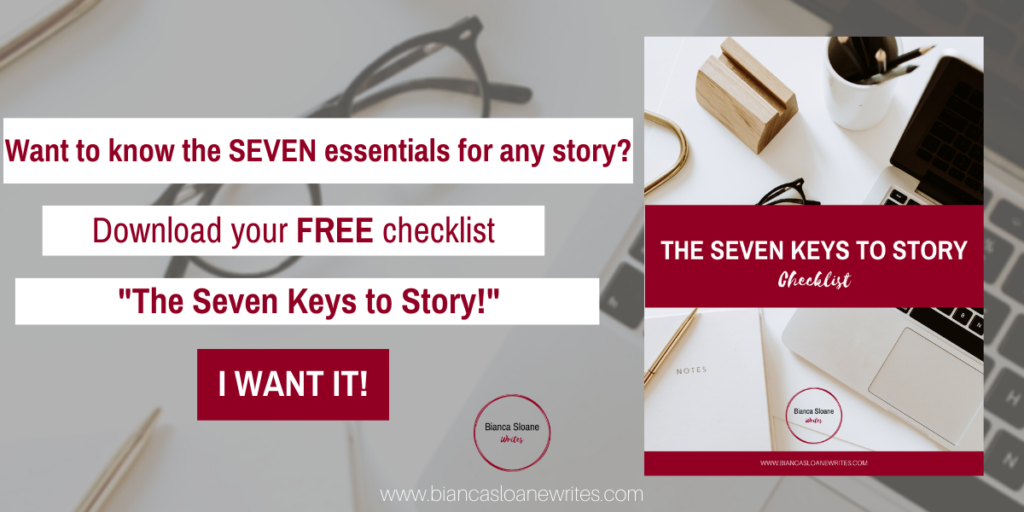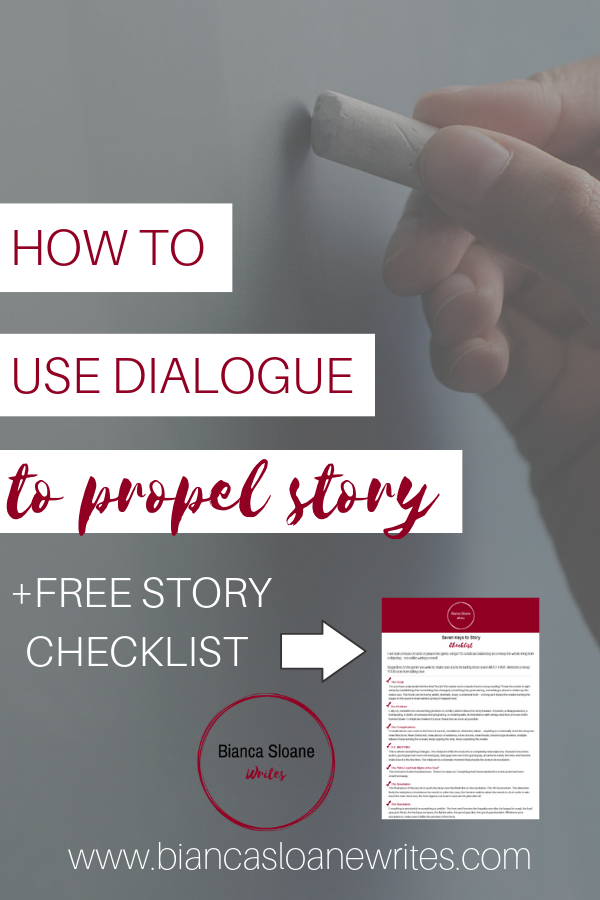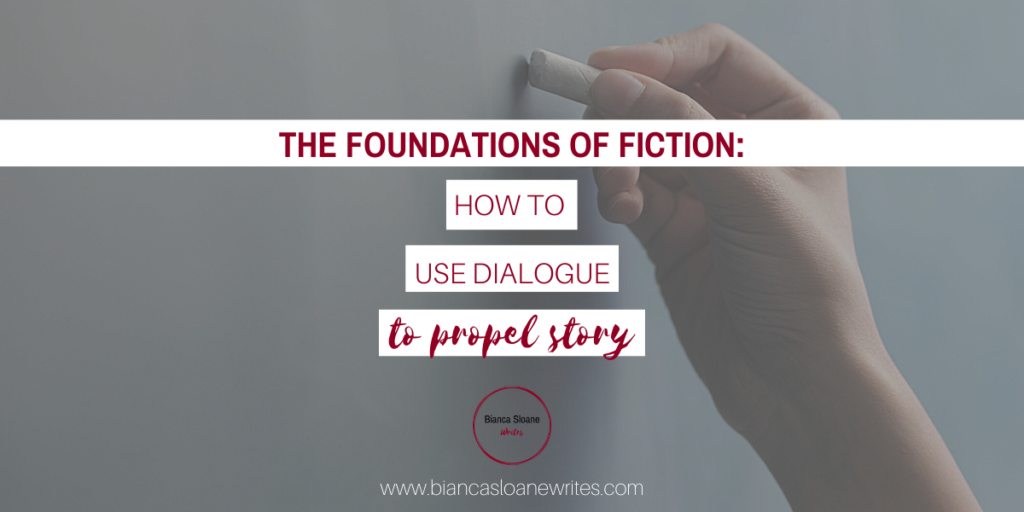Foundations of Fiction: How to Use Dialogue to Propel Story
Pop Quiz. Would you rather:
A) Read a dialogue exchange whereby Mary tells her husband, Bob, that her friend, Jane, pushed her husband, Joe, down a flight of stairs
B) Read a dialogue exchange where Jane tells her friend, Mary, she pushed her husband, Joe, down a flight of stairs
C) Read a dialogue exchange where Jane confronts Joe about his infidelities before she pushes him down the stairs.
I think we’d all choose “C” without hesitation.
The first two choices wouldn’t do anything to move the story forward. They’re merely recapping an event that’s already happened. There’s likely to be no conflict in these exchanges and no new information to send the story into an interesting, unforeseen direction. It’s just two people talking and nothing is happening while these two people are talking.

However, “seeing” Jane in a head-to-head with her husband about his betrayal, his likely denials, her agitation, the rising tension between them leading to an eventual stunning action, is a lot more interesting than hearing it told to us after the fact. The forward movement of the story is in the confrontation between the spouses, which leads to LOADS of conflict (a must with dialogue). Leaving Joe at the bottom of the stairwell at the end of the chapter compels us to turn the page to learn what happens next. Does Joe die? Does he survive? Will he remember what happened? Will Jane confess?
As we’ve previously discussed, dialogue is tough and often gets misused because its story purpose isn’t always clear.
Dialogue is meant to:
- Propel the story forward
- Reveal character
It is NOT:
- A dumping ground for exposition
- A dumping ground for mindless chit chat
- Meant to sound too realistic
In this Foundations of Fiction: Dialogue series, we’ll examine “PROPELLING THE STORY FORWARD.”
Moving the Story Needle
In fiction, a conversation isn’t just a conversation. It must have a purpose. A banal dialogue exchange about what two characters had for dinner or recapping an event with no new information or twists won’t cut it.
Read Foundations of Fiction: Dialogue – “REVEALING CHARACTER.”
(Read Foundations of Fiction: Dialogue on CONFLICT)
So, how do you move the needle forward in your story via dialogue?
Let’s use the novel, “Gone Girl,” by Gillian Flynn as our case study.
First, about “Gone Girl”:
On a warm summer morning in North Carthage, Missouri, it is Nick and Amy Dunne’s fifth wedding anniversary. Presents are being wrapped and reservations are being made when Nick’s clever and beautiful wife disappears. Husband-of-the-Year Nick isn’t doing himself any favors with cringe-worthy daydreams about the slope and shape of his wife’s head, but passages from Amy’s diary reveal the alpha-girl perfectionist could have put anyone dangerously on edge. Under mounting pressure from the police and the media—as well as Amy’s fiercely doting parents—the town golden boy parades an endless series of lies, deceits, and inappropriate behavior. Nick is oddly evasive, and he’s definitely bitter—but is he really a killer?

The main thrust of the novel is that Amy Dunne is missing and her husband, Nick, is the prime suspect. Every aspect of the story will revolve around getting to know Nick and Amy as individuals (revealing character) and as a couple (also revealing character) while unraveling the mystery behind Amy’s disappearance and Nick’s possible role in it. Even dialogue exchanges of seemingly innocuous “chit chat,” will eventually give us new information about the story’s central mystery.
Let’s start by breaking down a few snatches of dialogue and examining how they move the story forward:
Nick has called the police to report that his wife is missing and we learn something important about the day:
“Uh, I’m a little freaked out, obviously,” I started.
“I don’t blame you at all, Nick,” Gilpin said earnestly. He had pale blue eyes that jittered in place, an unnerving tic.
“Can we do something? To find my wife. I mean, because she’s clearly not here.”
Later . . .
“What anniversary today?” she asked.
“Five.”
The day that Amy disappears is the same day of her fifth wedding anniversary. This is a small tidbit, but it becomes VERY important later on. It also adds an immediate poignancy and urgency to the story—a woman missing on her wedding anniversary—we want to know if she makes it home to celebrate with her husband.
Later, detectives continue to question Nick about the day and he drops another decisive nugget of info…
“Five. Big one. Let me guess, reservations at Houston’s?” Gilpin asked. “It was the only upscale restaurant in town. You all really need to try Houston’s, my mom had said when we moved back, thinking it was Carthage’s unique little secret, hoping it might please my wife.
“Of course, Houston’s.”
It was my fifth lie to the police. I was just starting.
From the blurb, we know Nick lies. This is the first time he’s admitting to it. What are the other four lies? What else will he lie about? Why is he lying? Is it because he truly did something to Amy? Or for another reason?
The plot is thickening.
Later, things really start to get thick when a tip leads Nick and some of his friends to an abandoned shopping mall which has become a makeshift shelter for addicts, the homeless, and gangs (to name a few). One of Nick’s buddies is convinced the answer to finding Amy lies in the Blue Book Boys, who hang out at the mall, so they go there to question them:
“We’ll give you money, good money, if you can tell us anything about Amy’s disappearance,” I said. “You guys know a lot of people, maybe you heard something.”
I pulled out her photo. The Hillsams and Stucks looked surprised, and I realized—of course—this was only a macho diversion for them. I pushed the photo in Lonnie’s face, expecting him to barely glance. Instead, he leaned in closer.
“Oh, shit,” he said. “Her?”
“You recognize her?”
He actually looked stricken. “She wanted to buy a gun.”
Okay . . . now, it’s getting real. Lonnie has just revealed to Nick that Amy came to the mall with the express purpose of buying a gun. By now, Nick’s lack of affect over Amy’s disappearance and initial hesitancy to report Amy’s disappearance, first to the police and later to his in-laws, have started to make him look suspicious. Lonnie’s admission adds another layer to this ever-more mysterious disappearance. Why did Amy want to buy a gun? Was it to protect herself from Nick?

Another piece of the puzzle falls into place when Nick finds some incriminating evidence:
I knocked on Go’s front door and when she answered, smoking a cigarette, I told her I had to show her something and I turned around and led her without a word to the woodshed.
“Look,” I said, and ushered her toward the open door.
“Are those—Is that all the stuff . . . from the credit cards?” Go’s voice went high and wild. She put one hand to her mouth and took a step back from me, and I realized that just for a second, she thought I was making a confession to her.
We’d never be able to undo it, that moment. For that alone, I hated my wife.
“Amy’s framing me, Go,” I said. “Go, Amy bought this stuff. She’s framing me.”
And there it is. Amy is framing Nick for her disappearance (and possibly worse), said by Nick to his sister, Go, in plain, straightforward, no BS terms, sending the story into another new direction. Why is she framing him? Is it because she’s vindictive? Does Nick deserve it? What else does Amy have up her sleeve?
With each dialogue exchange, the tension ratchets up and the mystery of what may or may not have happened to Amy—and Nick’s role—deepens. The conversations have a purpose—sharing information, uncovering information, small revelations, major bombshells. Nothing is wasted. The dialogue continually pushes the story in a perpetually forward motion.
The Takeaway:
When developing scenes with dialogue, think about the how you want to use the dialogue to move the story forward. What are the dynamics at play? How will the forward motion from this particular dialogue exchange in this particular scene impact what happens next in the story? How does it push forward to the story’s ultimate resolution?
When it comes to moving the needle on your story, what clues, tidbits, revelations can you use? In a mystery story, a detective can glean new details of his case from a witness, giving him fresh suspects to consider. In a love story, it could be the first time the hero says, “I love you,” to the object of his desire. In a sci-fi/fantasy story, it could a revelation told to the protagonist by the antagonist about civilizations past that impacts mankind’s future. In a suspense story like “Gone Girl,” it could be why a husband is lying about his missing wife and why that wife is framing him for her disappearance.

Examine the dialogue exchanges in your story. Are you using them as opportunities to reveal new plot information or are they merely vehicles for chit-chat and pleasantries that go nowhere? If so, scrap them and start fresh with tidbits and revelations that keep your story moving toward its inevitable resolution.
What are some of your favorite dialogue exchanges that move a story forward?



